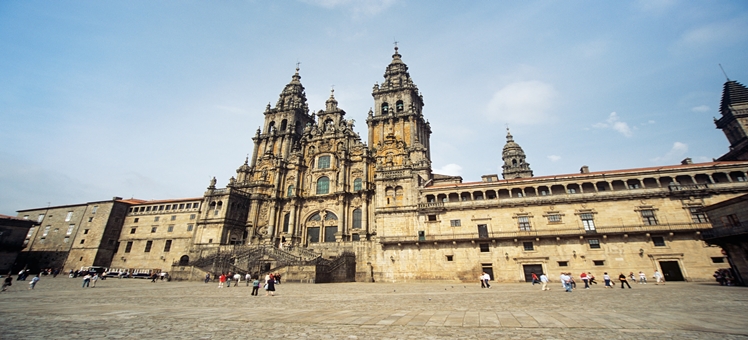
From sacred pilgrimage sites to ancient Celtic and Roman ruins, Galicia has plenty of historic sites to explore. Wander through cobblestone streets of Santiago de Compostela, relax in the therapeutic waters of the spa-town of Mondariz or sip on a Galician wine in a local bodega (wine cellar) in Ourense.
 Mark AuchinclosMy Destination local expert onGalicia
Mark AuchinclosMy Destination local expert onGalicia Santiago de Compostela
Santiago de Compostela
Declared a UNESCO World Heritage Site in 1985, Galicia’s capital city is replete with attractions. Aside from its striking Gothic cathedral drawing in crowds trekking along the Camino de Santiago (Way of Saint James), the capital has another hidden gem – its historic Old Town. Jostling with history and present-day life, this unique spot filled with medieval streets, tapas taverns and tiny boutique shops offers the perfect place to begin your explorations of Galicia.
Atlantic Islands National Park
Outlined by laurel forests and crashing Atlantic waves, this national park houses some secluded islands chains known as the Cíes, Cortegada, Ons and Salvora. Relaxing coastal spots to visit, these bio-diverse areas are famed for its abundant wildlife. Visitors can expect to see a wide range of native species including seagulls, shags, razorbills, guillemots and dolphins, all nestled within the lush surroundings of these Atlantic Islands. Also hidden here are some of Galicia’s most pristine beaches such as Praia de Rodas and Melide Beach, shimmering with white powdery sand and clear blue waters.
Tower of Hercules
Perched on a craggy peninsula in the city of A Coruña, overlooking the North Atlantic coast, is one of Galicia’s must-see attractions. Surrounded by a sculpture garden and containing almost 1,900 years of history, the ancient Roman tower has become a significant monument for the people of Galicia. With legends of Hercules slewing a fearsome giant on this site, interesting tales and scenic landscape will keep you occupied here for hours.
Roman walls of Lugo
Trailing around the historic centre of Lugo, these ancient city walls were constructed in the 3rd century. Today, still largely intact and clothing the city in well-preserved Roman fortifications, this historic attraction has become a local treasure. Complete an entire circuit of the city walls (approximately 2 kilometers long), soak up the panoramic views across the River Mino valley and stop by Lugo’s magnificent cathedral.
Valdeorras wine region
Translated as ‘Valley of Gold, this shimmering area of fertile soil and undulating river valleys is famed for its avid wine production. Nestled in the Ourense province - an already established spot for wineries - this region has a long history of growing grapes. Vineyards are dotted all along the banks of the River Sil, offering authentic tastes of the local Godello wine.
Baiona
Sprinkled with turreted towers and medieval walls encased by a landscape of verdant woodland, Baiona is one of the most picturesque parts of Galicia. Located right on the harbor-front, small fishing boats and luxury yachts bob around the scenic bay in summertime. Also a place of significant history, it was here in 1493 that the Pinta - captained by Pinzón - arrived in Baiona, making it the first port in Europe to receive news of the discovery of America.
Mondariz
A charismatic village filled with thermal spas, Mondariz is a relaxing haven found in Pontevedra. Surrounded by the dramatic silhouette of dense woodlands and rugged mountains, healing spas and bathhouses populate the area, radiating a soothing atmosphere throughout. Home to Galicia’s oldest geothermal spa - the Balneario de Mondariz - served by underground thermal springs, this tranquil spot is the perfect place to unwind.